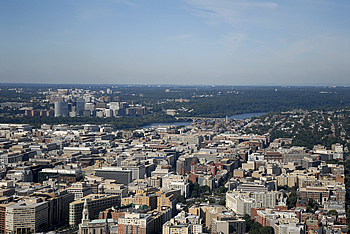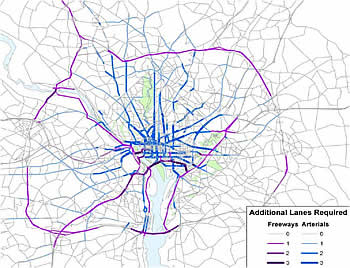Why Metro Matters
Read the action plan from Metro General Manager/CEO Paul J. Wiedefeld:
"Keeping Metro Safe, Reliable and Affordable" (Published April 2017)
Metro made the case for transit to identify and quantify the wide range of benefits that have accrued to the region since Metro (rail and bus) opened. Looking back, Metro has had a much greater impact than sustainably moving people within the region. Metro has supported the development of the real estate market, generated tax revenues, and been the key to the region's economic vitality.

Development in Washington DC core and Rosslyn in Arlington County have been supported by transit access
Making the Case for Transit began with the premise that without transit, the region would look and operate very differently than it does today. By imagining the region without transit, it was possible to understand transit's role and value to the Washington economy. The study is not a formal cost-benefit analysis. Instead, it presents the benefits of transit in as many ways possible to demonstrate the magnitude of its impact. While transit is an integral part of many of these benefits, the impacts brought about by zoning, development decisions, and long-term transit-supportive policies at the local and state levels cannot be ignored. In this study, only benefits where transit was either a precondition for or an integral part of an impact were measured.
The major regional benefits can be classified as shown below or in the
two-page brochure version ![]() . Additional information can be found in the report
Making the Case for Transit: WMATA Regional Benefits of Transit (November 2011)
. Additional information can be found in the report
Making the Case for Transit: WMATA Regional Benefits of Transit (November 2011) ![]() .
.
Increases Property Value Around Transit
An analysis of parcel-level property tax assessments for all properties within a half-mile of Metrorail stations shows:
- $235 billion of property value is within a half-mile of Metrorail stations.
- This land generates $3.1 billion annually in property tax revenues.
- This land represents 28% of the jurisdictions' property tax base, but only 4% of their land.
- Proximity to Metrorail increases property values by 7-9%.
Moves the Region Forward: What if There Were No Transit?
An analysis of congestion and trip making patterns if there were no transit in the region shows:

- Vehicle-miles traveled would increase by 7-8%.
- Congestion would increase by 25%, costing more than $1.5 billion annually in wasted time and fuel.
- The region would fragment into several smaller economies resulting in the loss of regional economic competitiveness.
- Employers would have access to a much smaller pool of employees and residents would have fewer jobs within an acceptable commuting distance.
Moves the Region Forward: What If Roads Were Built Instead of Transit?
An analysis was conducted to ascertain the amount of auto-oriented infrastructure that would have been needed to accommodate all of the trips that are currently on transit. It shows:
- More than 1,000 lane-miles of new pavement on highways and arterials would be needed, which is the equivalent of two new Beltways. All river crossings would need 4-6 additional lanes.
- One million more auto trips per day would be made.
- Two hundred thousand more parking spaces in the core would be needed, which would be the equivalent of 166 blocks of five-story garages.
- Commercial and residential development opportunities would be lost. Existing neighborhoods would be fragmented or lost.
Increases Access to Jobs and Business
An analysis of the surrounding land uses shows:
- Two million jobs or 54% of all jobs in the region, within a half mile radius of all Metrorail stations and Metrobus stops.
Makes the Region Affordable and Livable
An analysis of trip patterns and travel times shows:
- Metro saves all households $705 million/year in time savings, whether they take Metro or not.
- Households using Metro save $342 million/year in auto expenditures due to reduced car ownership, operating, and maintenance costs. This includes saving 40.5 million gallons of fuel annually.
- Each weekday morning, Metrorail riders walk a combined 33,000 miles to a station, burning 2.2 million calories.
- Metro enables 360,000 trips by transit dependents per day.
- Metro enables 20% of rail riders and 53% of bus riders to live a car-free lifestyle.
- Transit improves air quality by avoiding 260 tons of VOCs, 22 tons of PM, and 0.5 million tons of CO2 due to reduced auto use.
Creates a Capital Region that Works
Metro helps the nation's capital region by:
- Moving employees of 277 federal agencies daily.
- Serving the federal workforce, who represent 35% of the morning peak period commuters.
- Enabling special events like festivals, sporting events, and inaugurations. Metro provided 1.1 million rail trips and 423,000 bus trips on Inauguration Day 2009.
- Enabling the evacuation of more than 120,000 people per hour on Metrorail.